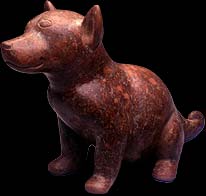
|
![]()
The entire eastern seaboard of the U. S. was home to a large group of complex, related cultures who lived in large cities and built immense earthworks still visible in the landscape today. They left behind art in all mediums, including stone sculpture, incised and painted pottery, and refined personal ornaments made of ceramic, metal, and shell.
Painted pottery is a highlight of the arts of ancient civilizations of the American Southwest. These people created masterpieces of clay, such as sophisticated pots, and most notably their own homes in the pueblo cities whose ruins can be seen today. Artists of the Mogollon, Hohokam, and Anasazi all created distinctive ceramics remarkable in their use of imaginative decorative, symbolic, and representational designs. These complex images were painted directly on each vessel, freehand, without any preliminary drawing. They represent a number of themes in ancient American life, showing animals and people undertaking both everyday and ceremonial activities. Abstract depictions of rain, clouds, and thunderstorms are striking.
Water was of utmost importance in this dry, desert land. This beautiful Socorro-style pitcher from what is now Arizona, painted in striking black on white, shows symbolic three-step cloud forms and zigzag lines representing lightning all around its middle. Generously donated by The Regis Foundation, the vessel is a classic example of skill and inventiveness. Direct descendants of these talented and most likely female artists live in the area today, creating masterpieces just as their forebears did.
Some of the most varied and accomplished art in all of the Americas comes from the civilizations of ancient Mexico. The Institute is fortunate to have exceptional artworks from a majority of these cultures, and some classic examples are featured in the Sacred Symbols exhibition. The first comes from the Olmec, who flourished in central Mexico from 1200–300 B.C. Olmec artisans built remarkable stone cities, and are justifiably famous for their sculpture. The small but stately statue in this exhibition is a gift from Alfred Lawrence.
In contrast to the regal stillness of the Olmec aesthetic, art from the neighboring cultures of west Mexico is known for its liveliness. Some of the best examples of this style are the lifelike dogs sculpted by the Colima, renowned for their high-quality ceramics. Dr. and Mrs. John R. Kennedy generously donated a charming canine, which looks ready to jump up and play. Beyond mere pets, dogs were associated with the god of thunder and lightning and were believed to be guides to the spirit world. Owing to their spiritual power, dogs were also ceremonially eaten in ritual contexts.
Images: Ancient Puebloan (Anasazi), Southwest region (United States), Pitcher (Socorro Style), twelfth century, Ceramic, pigment, 7 3/4 x 7 1/2 inches, The Minneapolis Institute of Arts, Gift of the Regis Collection, 97.80.1
Colima, Mexico, Dog, 100–300
Ceramic, 9 1/2 x 6 1/16 x 13 1/16 inches, The Minneapolis Institute of Arts, Gift of Dr. and Mrs. John R. Kennedy, 99.57.3





